The organization of space and time in the quartier Mu of Malia (Crete, bronze age, 3200-1100 BC), in light of lamps
Ph.D candidate, Arscan, Université Paris 1 Panthéon-Sorbonne
English Translation of "L’organisation de l’espace et du temps au Quartier Mu de Malia (Crète, âge du Bronze, 3200 – 1100 av. J.-C.), à la lumière des lampes" by Arby Gharibian.
In recent decades, the development of virtual reality has allowed us to propose realistic reconstructions of lighting in Bronze Age buildings of the Eastern Mediterranean and Aegean world. However, light and darkness have been studied separately: the former in relationship to everyday life, the latter in connection to night activities, rituals and religion. Studying a Middle Bronze Age Cretan city and its corpus of lamps, we can identify several lighting devices, of various kinds and functional qualities, the analysis of which contributes to revealing a Minoan lived space where light and darkness cannot be segregated.
Introduction
During the Bronze Age (3200-1100 BC), the Eastern Mediterranean was marked by the dual emergence of the first states and cities. In Crete, urbanization trends led to the emergence of what could be called “towns”1according to the definition of geographers.2 This development was accompanied during the Middle Minoan by the rise of palaces, which most certainly served an economic function for storing and redistributing wealth,3 even though their precise political and/or religious nature remains unclear.4
Recent research has given greater attention to the importance of light in constructing urban reality in the Eastern Mediterranean.5 Architectural studies in particular have used virtual reality in order to offer realistic reconstructions of natural and artificial lighting. Based on data about light properties recorded in experimental research programs6, those reconstructions often use luminosity as a criterion for the identification of areas of activity, and as an indicator as to the temporality of their occupation7.
Those studies, as highlighted by David Petrut, Monica Gui and Horea Trinca8 in another chrono-cultural framework, dissociate light from darkness, linking the former with the understanding of everyday life during the daytime9 and the latter with nighttime,10 that has often been studied in connection with rites and beliefs.11 No one any longer imagines—as Philippe Bruneau12 once did regarding Delian houses—interior spaces immersed in darkness in the middle of the day, or on the contrary lighting systems on the exteriors of buildings at night.
However, the notion that one could transition from darkness to light within the same space at a given moment, both during the day and at night, calls for further exploration as it can shed light on our understanding of societies, regarding their organization and their relationship with domestic place and daily time. Our approach, that aims at achieving such a demonstration, is based on a homogeneous collection of lamps discovered in the Quartier Mu of Malia, a complex dating from the second millennium BC. Given that one of the distinctive architectural features of this area is its highly dense built space, one can assume that certain areas, particularly in the center, were immersed in darkness both by day and by night. This would partly explain the use of artificial sources of light, whose spatial distribution will be analyzed below. The experimental and statistical data analyzed suggest a space that was unequally lit, with respect to both light ambiances and the techniques implemented. A quantitative approach is significantly different from three-dimensional qualitative models, as it can examine the connection between light, darkness, and activities on the scale of the neighborhood, and not just the room. This preliminary reflection deserves to be subsequently extended, in a further study, to other light sources (hearths, braziers and openings).13
Back to topPresentation of the site and lamp collection
Quartier Mu of Malia, a Middle Minoan urban space
This area measuring over 3,000 m2 belonged to the Minoan city of Malia, located in the Mirabello plain along the Northeastern coast of Crete (fig.1). The excavations conducted in Malia since 1915 have gradually unearthed a Bronze Age city organized around a first (2000/1900–1700 BC) and later a second palace (1700–1450 BC) (fig.2).
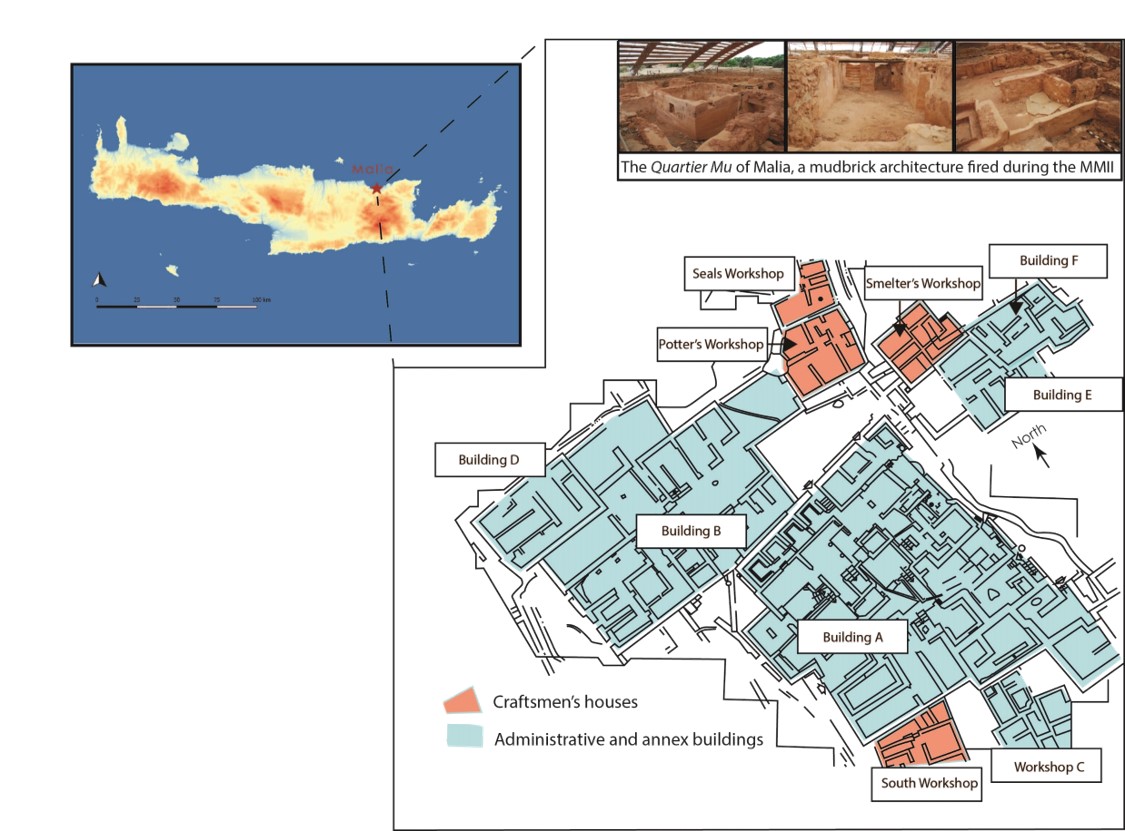
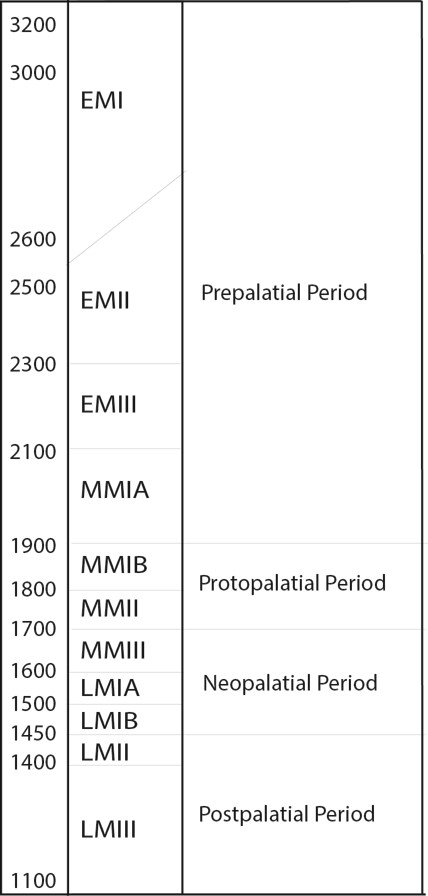
In a number of respects, the excavation of the Quartier Mu conducted between 1965 and 1991 proved decisive to the understanding of the history of the protopalatial period in Northeast Crete. In addition to the chronological ambiguities resolved by the study of ceramics,14 this excavation also revealed a first for the island, a craft and administrative center. Both the architecture and objects are in an excellent state of preservation. The buildings, which were made of mudbrick and perishable materials, melted during the fire that destroyed the site and created a solid clay lid “protecting” the remains from agricultural activity and erosion.15 Ceramic material, which is a relevant chronological and cultural marker in archeology, made it possible to date this complex to the MMII.16 Despite the numerous architectural phases, notably between the north and south portions of building A,17 the destruction by fire at the end of the MMII period provides a snapshot of the site’s final moments of occupation.18
The function of buildings is relatively well known. The monumentality of buildings A and B (840 and 540 m2), along with the existence of a “palatial” architecture and the presence of certain archival material in Cretan hieroglyphics, clearly suggest that these buildings had an administrative function linked to the first palace, which was located only 140 meters away.19 Craftsmen’s houses were also discovered, and represent a unique example for Minoan Crete (Potter’s Workshop, Seals Workshop, Smelter’s Workshop, South Workshop). Analysis of the distribution of the objects found suggests that craft activities took place in the basement and on the ground floor, in addition to the floors on which families lived.20 Finally, a number of buildings, which at first glance appear to have multipurpose functions, have been identified as annex-storehouses, including buildings C and F.21 The commonly accepted model for the Quartier Mu depicts craftsmen in the service of the palace, receiving in exchange the raw materials they needed for their daily life and production.22
Lighting Devices in Crete
Research has revealed the existence of two parallel lighting systems in Minoan towns: openings that provided natural light,23 and devices for the production of artificial light, namely stationary and mobile hearths24 and lamps.25 While other artificial lighting systems were certainly used, given the observations made in various ethnographic contexts,26 there is no proof of their use within the archaeological record. Devices such as a candlestick have not been discovered or identified so far (there is yet no functional study for items such as the possible “chandelier” from the protopalatial levels of Phaistos that is exhibited at the Heraklion Archeological Museum). We do not have, as we do for the Levant, examples of wall fixtures that could have served as lamp holders.27 Finally, if torches existed, they have not been conserved. The only possible example was found on the levels dating from the Late Minoan III (LMIII) in another area of Malia, the Quartier Nu,28 namely at the very end of the Bronze Age. In this context, the iconographic and textual evidence offers limited help. Cretan wall paintings, seals and sealings do not depict lighting devices. The texts in Linear B from the fourteenth to the twelfth centuries BC mention vegetable oils, although the use of these products as fuel can only be guessed at, as no specific function is mentioned.29
Lamps among the lighting devices of the Quartier Mu
In the Quartier Mu of Malia, lamps are the most common object among artificial sources of light. The great chronological homogeneity of this collection prompted our exclusive focus on these objects in this article. The analysis will then be extended to the other sources of artificial light that were found (hearths, braziers), as well as to openings for the best preserved buildings. During our research at Malia we studied 168 lamps, of which 159 are made of clay and 9 of stone (serpentine).30 The excavator classified these objects according to their morphometric characteristics.31 This typology proposes 9 types, sometimes divided into sub-types. Types 1 to 5 are clay hand lamps. Types 6 to 9 are clay lamps equipped with a tall stand, also referred to as pedestalled lamps (fig. 3). Stone lamps are not included in this typology, belonging instead to vase type 24 as published by Peter Warren,32 although out of convenience we will refer to them as type 10.

Within this group, types 2 and 9 include a broader range. Type 2 includes lamps with a low base, straight truncated spout, and loop handle opposite the spout. This group is further divided into two sub-categories: type 2a whose base is columnar in shape, and type 2b whose base is conical. Type 9 includes three sub-types: pedestalled lamps with a concave rim below, equipped with vertical lugs and two wick cuttings (type 9a), pedestalled lamps with a concave rim below, equipped with two diagonal lugs and two wick cuttings (type 9b), and finally pedestalled lamps with a raised edge, equipped with vertical lugs and two wick cuttings (type 9c). If we do not take into consideration these morphological details, which apparently did not have an impact on how the lamps were used, one could say that four categories of forms exist: hand lamps with a spout, handle, and rim turned inwards; hand lamps with a spout, handle, and hollow rim; lamps with two spouts, two handles, and an open form; and finally pedestalled lamps with one or two spouts, one or two lugs, and a flat rim.
Publications offer no clear distinction between objects discovered in situ on the ground floor and the semi-basement, and those fallen from upper floors.33 We will therefore propose a distribution by building, following Jean-Claude Poursat's approach (fig. 4). Distribution analysis of each lamp type in the environment shows that there are many hand lamps of type 1 and 2 in building A. Their association with tableware in this space could indicate their use during feasts or ceremonies.34 Types 3 to 7, which are fairly rare, can be found in buildings A, B and D, craftsmen’s houses, and in the east and west outdoor areas.35 Type 8 and 9 lamps, which had hitherto been discovered in funerary contexts36—and for type 8 in the “MMII sanctuary” contemporary with the Quartier Mu—were very present in the ceremonial areas of building A,37 but were also found in buildings B, D, and E, in addition to the South Workshop and Potter’s Workshop. Building B also provided a few stone specimens.38
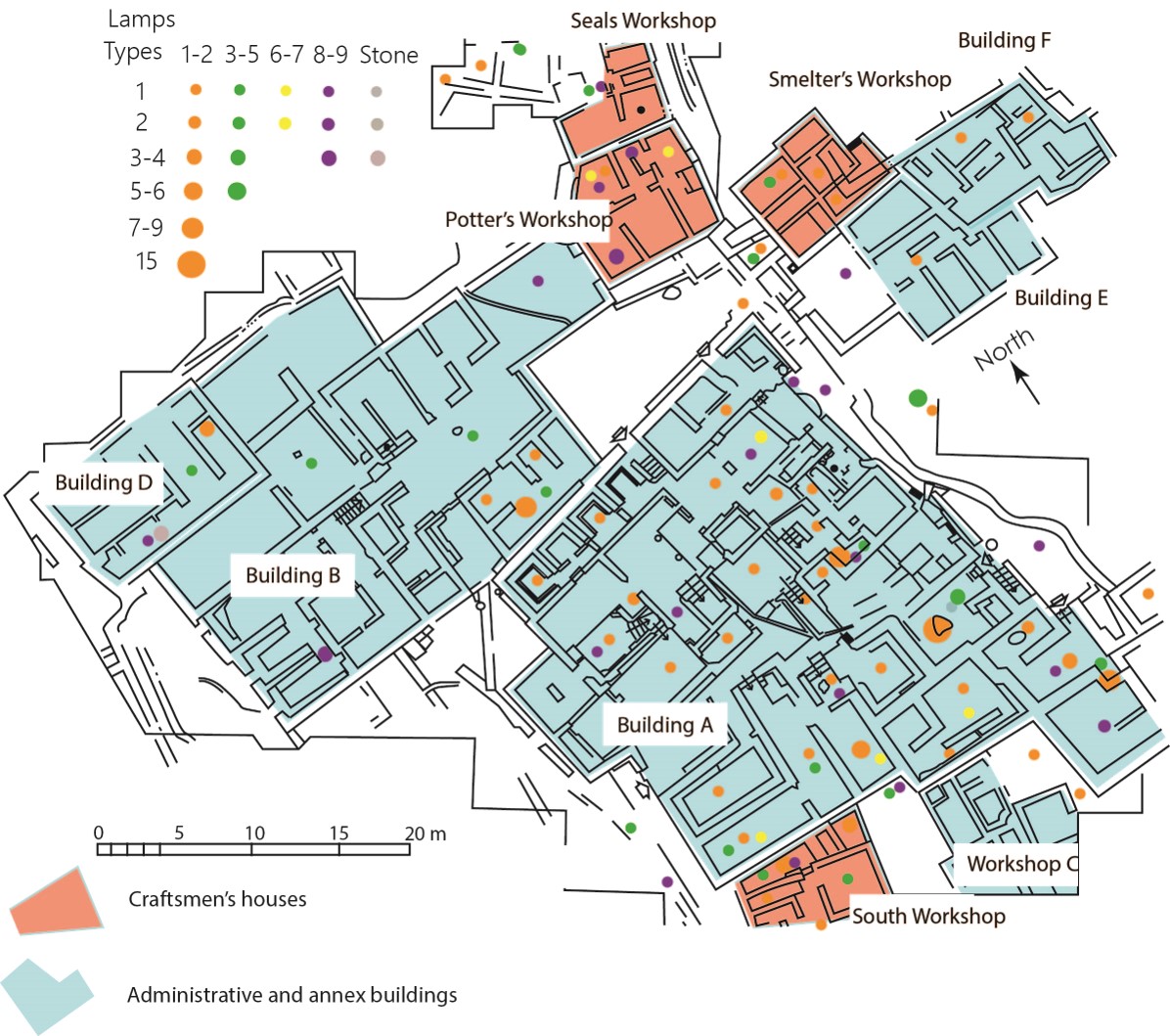
Defining the Functioning of Lamps: Burn Time and Transportability
As part of an experimental program, we studied both how lamps function as artificial lighting devices, as well as how they were used in the context of everyday life activities. Three replicas (one made of stone and two of clay) were produced, based on specimens discovered in the archeological record (fig. 5): type 2 (Lamp I) and type 1039 (Lamp III) hand lamps, and a type 9 pedestalled lamp (Lamp II).

Transportability
Assuming the traditionally adopted division in typologies between hand lamps and pedestalled lamps, we firstly tried to define criteria of transportability for these objects. An initial experiment, conducted with manually held lamps, involved moving with each of the experimental copies through the dark inside a Parisian apartment, while using two types of fuel attested in the paleoenvironmental record, namely olive oil40 and pork fat.41 The use of these two materials, one liquid and the other solid, helped to explore the impact of fuel consistency on transportability. Linen, which is mentioned among other vegetal substances in Linear B tablets,42 was used to produce twisted wicks based on a process validated by a number of experimental programs.43
This experiment showed that a lamp is easily transportable when only one hand is needed to hold it, which allows for simultaneously completing other actions (opening a door for instance). The orientation of the lamp’s body and/or bowl depth also emerged as discriminating criteria. The body must be sufficiently deep and/or the rim must curve inward to prevent the fuel from spilling. Finally, in order to be moved, the lamp must be relatively compact, which is to say its weight and dimensions must not be a constraint during transport. When these characteristics are all present, the nature of the fuel does not make a major difference. The initial solidness of animal fat and beeswax, which could at first glance seem to be a factor suitable for mobility, is not very useful in reality, as the flame’s heat melts the materials. According to these observations, lamp A is suitable for transport, as it can be moved with one hand and has a closed rim, thereby preventing the fuel from spilling over. On the contrary, type 9 and 10 lamps are difficult to move due to their open form, and bulky size (Lamp II) and weight (Lamps II and III) (fig.6).
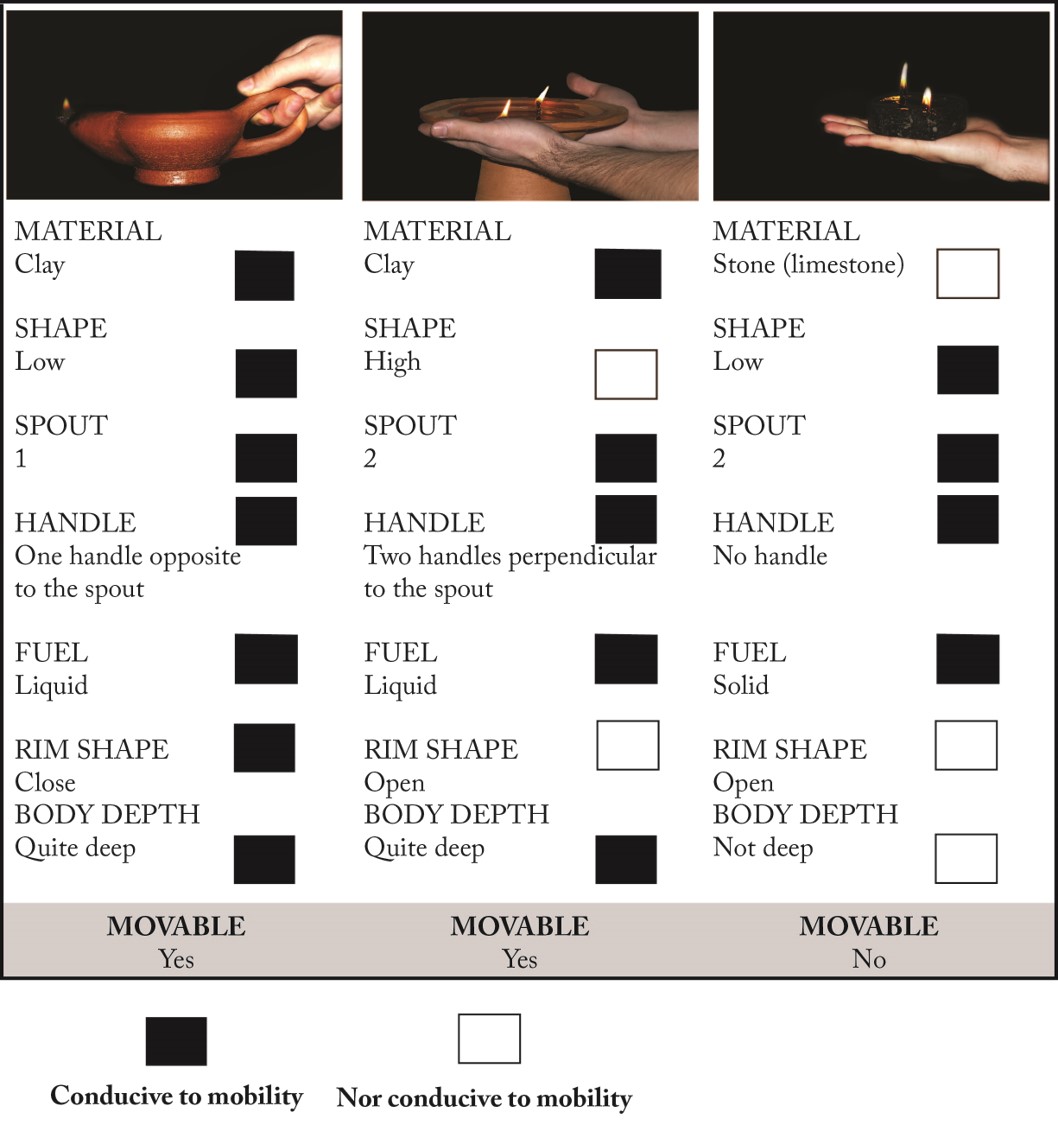
Burn Time
In the second experiment, we sought to measure burn time (fig. 7). The parameters affecting this technical aspect were defined in a series of six tests, noted A to F. The materials used were the same as in the previous experiment, with the addition of beeswax. This substance was identified by residue analysis in lamps from the Minoan site of Mochlos.44 The experiment consisted of allowing combustion to proceed without intervening on the flame. Photographs were taken every twenty minutes to document the evolution. The results show that lamp capacity is the primary parameter affecting a flame’s lifespan. Capacity was measured using styrofoam balls,45 which indicated that lamp I has a capacity of 0.25 liters, while lamp III has a capacity of 0.03 liters.46 In test A, in which lamp I was used with olive oil, burn time measured 41:58, while in test C, in which lamp III was used with olive oil, it was limited to 5:40. The type of fuel also had an impact, for with an equal number of wicks (1), animal fats (tests B and C) ran out more slowly than beeswax (test D). The same results were obtained for lamps using two wicks (tests E and F), as suggested by the presence of two spouts. The differential lifespan of a flame for two fuels of the same type is related to how the fuel is absorbed. The wick’s capillary action is greater with liquid materials than solid ones. For instance, the flame lasts longer near the spout when olive oil is used, as the fuel “rises” regularly along the length of the wick. Conversely, the flame has a tendency to “move” along the wick in order to reach the required fuel when animal fats or beeswax in particular are used. Melting takes place randomly, which consequently distributes the flame along the entire wick, thereby reducing burn time.
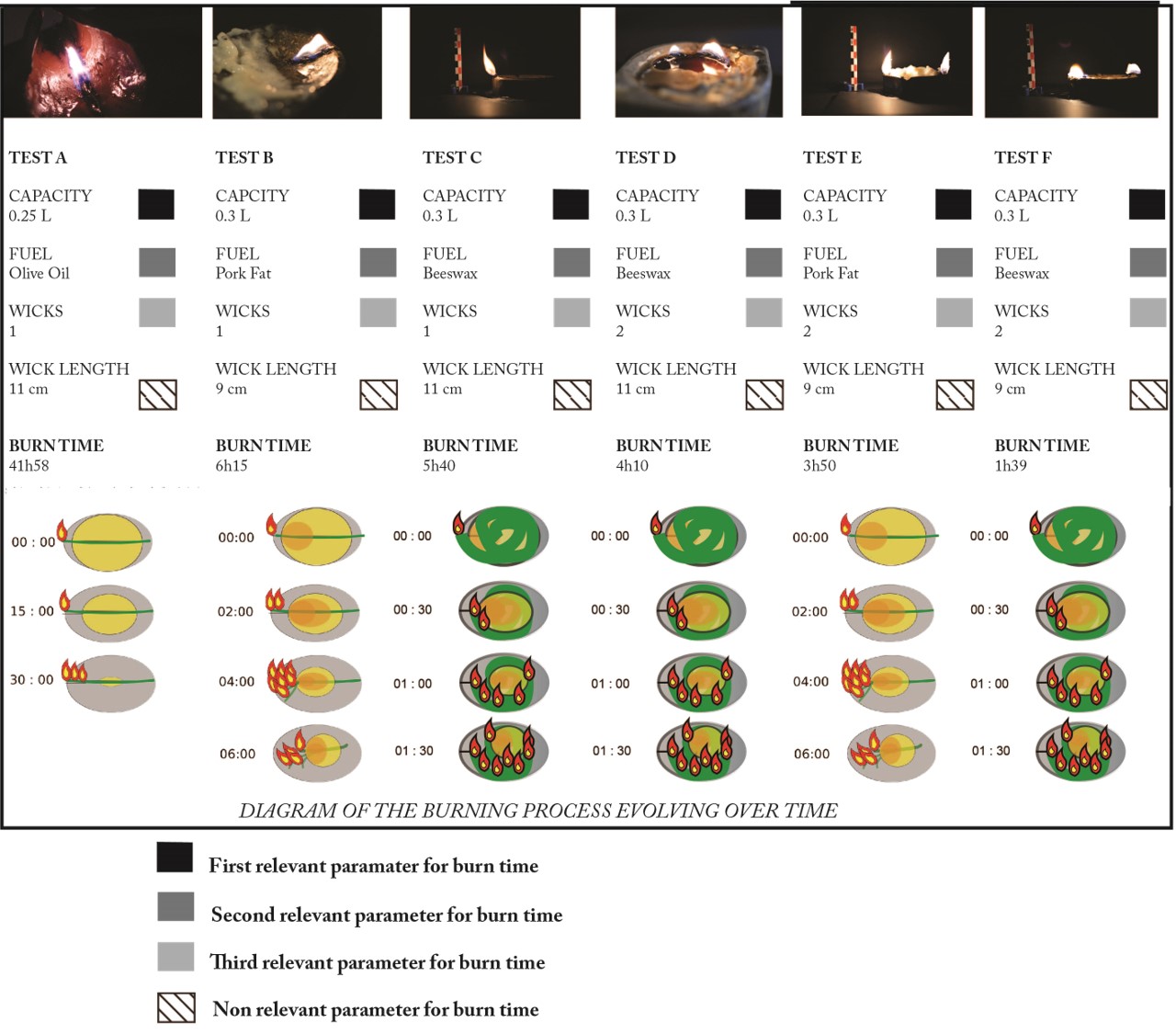
Despite these “poor” technical characteristics, beeswax was indeed used as fuel in the lamps of Mochlos. One may assume that this material offered other qualities, for instance its odor. Along the same lines, light measurements conducted with a photometric cell in a series of 23 tests with vegetable oils, animal fats, and beeswax, using wicks made of linen, hemp, jute and papyrus demonstrated that the type of fuel determined the color of the flames produced.47 This information suggests that light perception could also have influenced the choice of materials used to produce it.
The experimental program conducted on transportability and burn time helped explore how lamps from the Quartier Mu of Malia functioned. The use of styrofoam balls to measure the capacity of a group from this collection (N=45) established the average capacity for a number of morphometric types (1, 2b, 4, 6). The results, which are supported by the experimental tests, demonstrate that the average burn time for lamps from the Quartier Mu of Malia, using a liquid fuel and with no human intervention on the wick, ranged from 20 (type 2b) to 60 hours (type 6) (fig. 8). According to our experiment, the burn time for type 4 (48h) was closer to that of type 6 (60h) than to types 1 and 2 (respectively 25h and 29h). As a result, functional analysis suggests that the strict division between lamps both without (types 1 to 5) and with (types 6 to 10) a stand must be reconsidered. Two functional groups appear: lamps with low capacity and high transportability (types 1, 2, 5), and lamps with high capacity and low transportability (types 3, 4, 6, 7, 8, 9) (fig.8).
This assessment is based on the assumption of exclusive use of vegetable oils, which is naturally a simplification. A study of soot deposits, which are powerful indicators of fuel type, is currently underway. Modelization based on solid and semi-solid fuels can be conducted where required. For the time being, the results differ in particular from those published by Marie-Claire Amouretti,48 who estimates a burn time of approximately 2h30 for ancient lamps with bowls of much smaller capacity. This data proved useful in grasping the spatial organization of lighting devices in the Quartier Mu of Malia.
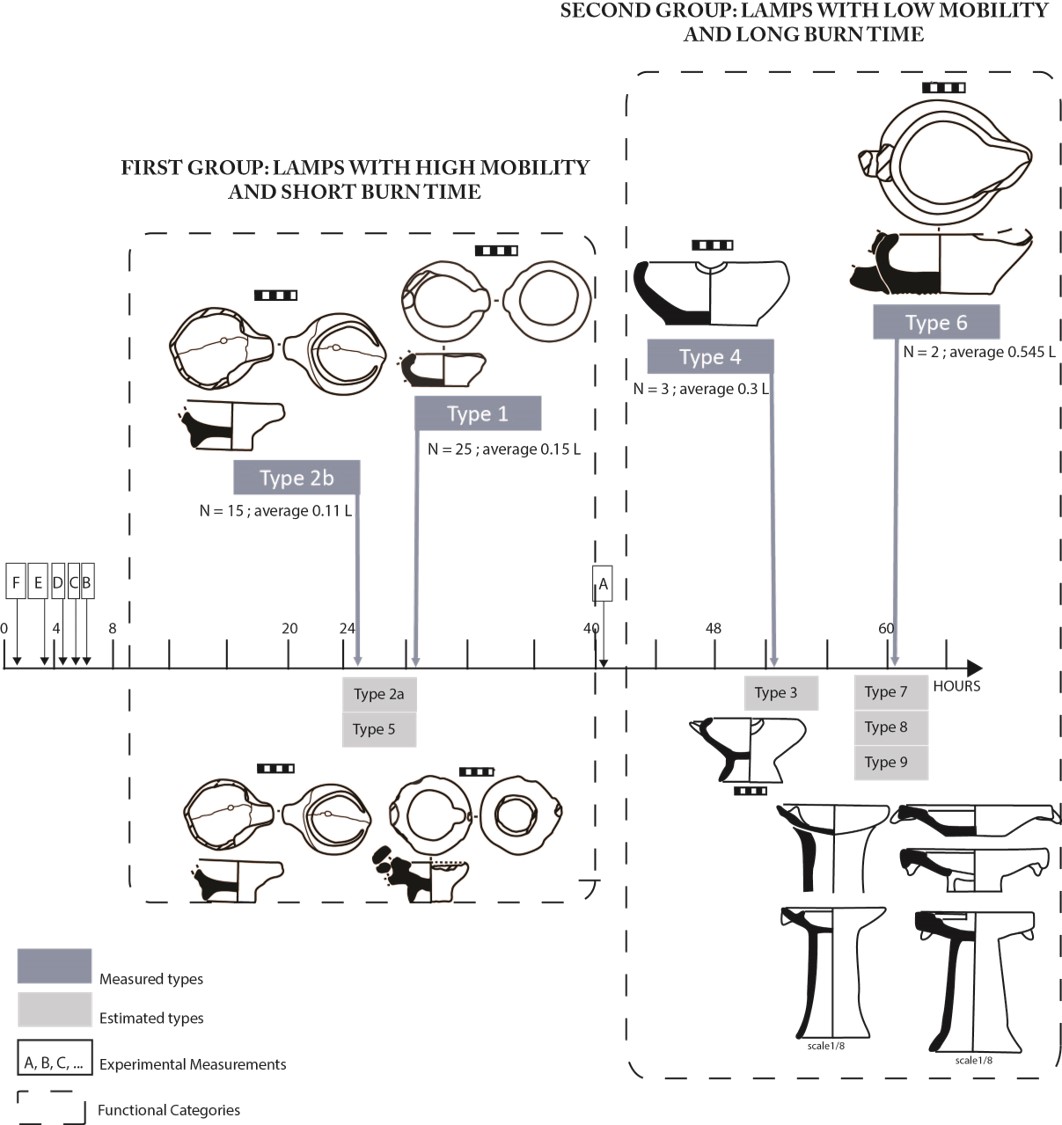
Artificial Lighting and Spaces in the Quarter
A luminous division of space?
The preferential associations of lamp types and buildings were depicted using a matrigraphe Pourcentages de Valeur d’Indépendance, called a matrigraphe PVI (fig. 9). In this type of representation, black squares indicate numerical overrepresentation, and white squares numerical underrepresentation. The gray squares indicate the average value of the number in question.49
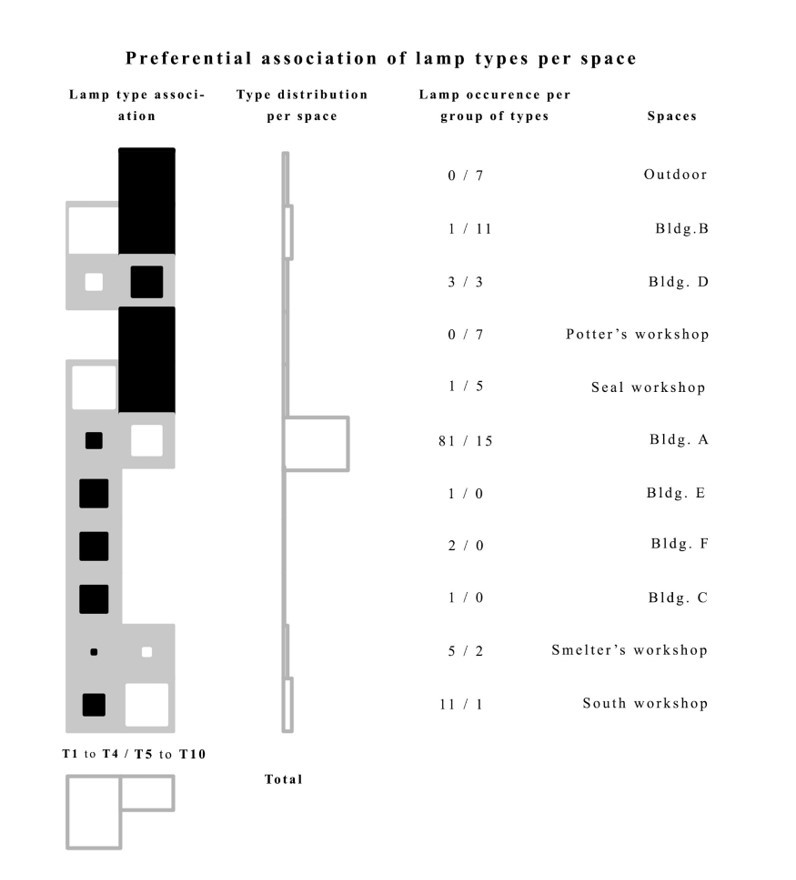
The analysis included a relatively small group (N = 168) and encountered a major bias, namely the proportional inequality of groups by building (fig.10). However, these exploratory statistics seek to prove the relevance of transforming qualitative data (a lamp’s function) into quantitative data (spatial distribution of morpho-functional types). We are aware of the limits of this approach, and plan to increase group size in a future study, notably by including collections from other sites from the same period.
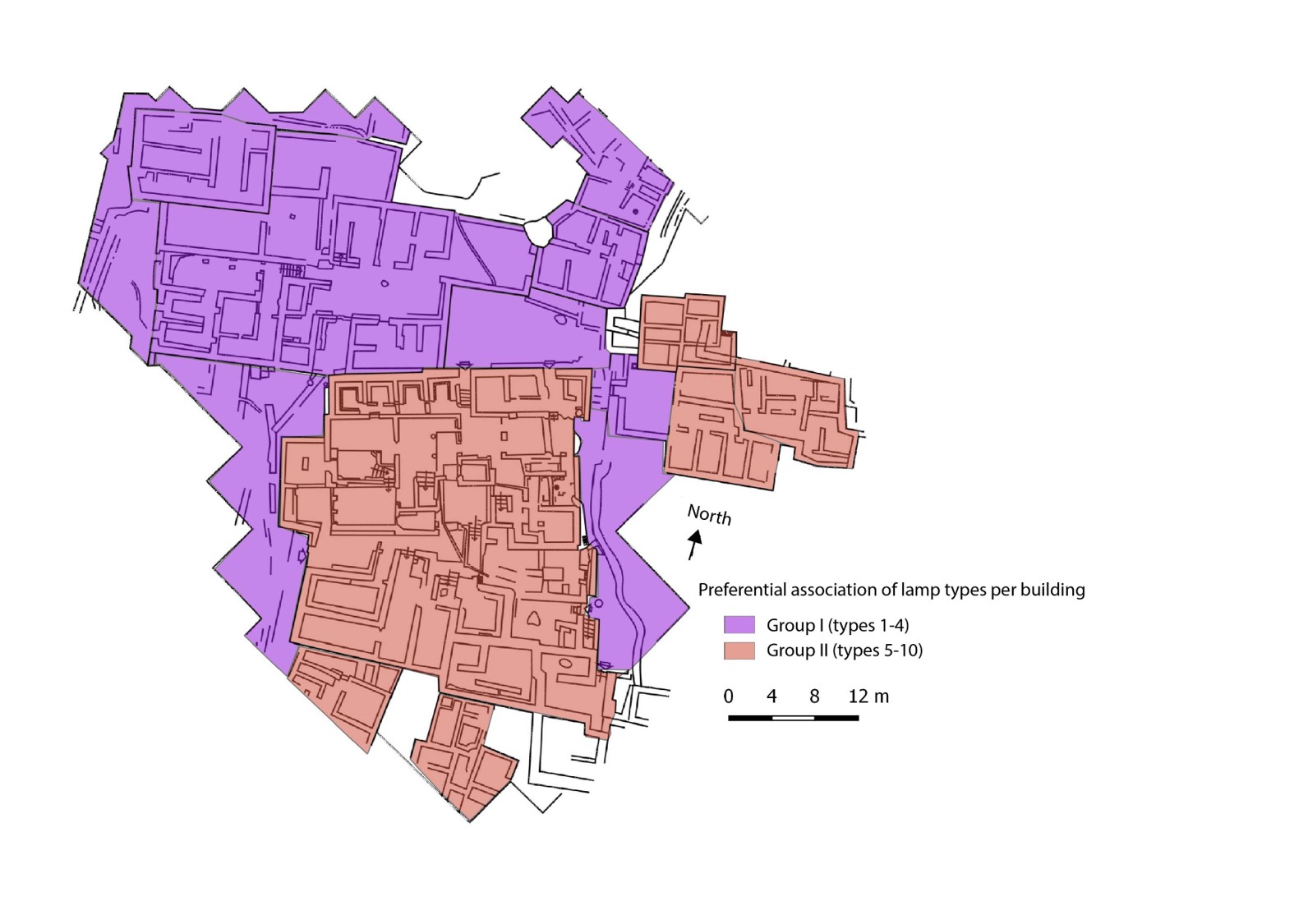
In the Quartier Mu, lamp types 5 to 10 are overrepresented in the outdoor areas (north space, east and west roadways, west walkway, small east plaza, space IV1), buildings B and D, and the Potter’s and Seals Workshops. Lamp types 1 to 4 are overrepresented in buildings A, C, E and F, the South Workshop, and the Smelter’s Workshop. In view of the results from the experimental program, this means that lighting devices functioned in a binary manner within each of the buildings, by combining stationary lamps with medium or long burn time, and mobile lamps with shorter burn time. Type 1 to 4 hand lamps tend to be excluded in outdoor areas, buildings B to F, the South Workshop, and the Potter’s Workshop, as do type 5 to 10 lamps with and without a stand. There are therefore two groups that correspond to Jean-Claude Poursat’s typology.
The cartography of these associations reveals two distinct areas (fig. 11). Group I (types 1 to 4) is located in the south of the quarter, while group II (types 5 to 10) can be found in the north, as well as in outdoor areas. This north area was therefore probably home to spaces where people spent time and engaged in activities, thereby requiring lighting that was both stationary and of long duration. The south of the quarter was most likely occupied occasionally, for instance in order to get supplies from storerooms, or for activities that did not require mobile or long lasting lighting. This analysis will be further developed in our research. We are notably interested in the north section of building A, where a number of pedestalled lamps were found. The ceremonial and staterooms identified here suggest activities that were more similar to those in the north of the quarter than in the south.
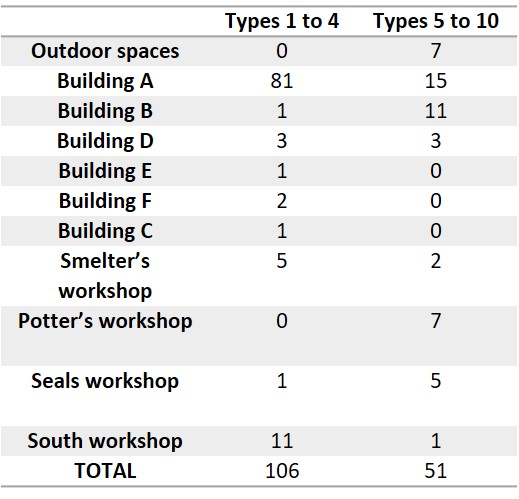
Light and darkness in the activities of the Quartier Mu. Initial results
Type 1 to 4 Lamps
The many occurrences of lamp types 1 and 2 in building A were analyzed in light of the “feast” activities that took place in this structure, based on the presence of vases for serving and consumption.50 The overrepresentation of type 1 to 4 hand lamps in the South Workshop and Workshop C is noteworthy. The objects found in the South Workshop indicate that this space was the site of various craft activities, notably the production of stone and metal vases, and possibly objects made of bone.51 Workshop C has been identified as a second smelter’s workshop, notably due to the presence of a schist mold in a semi-basement, along with three oven tuyeres and two saws with schist blades, all located in the small courtyard VI4.52 A cache beneath the floor of storeroom VI1 yielded three tripod bronze vases and a lead weight.53 Hand lamps were nevertheless also present in the Smelter’s Workshop. Given the apparent links between hand lamps and metallurgic activities within the three spaces discussed here, one can imagine that the lamps were used in the production of metal objects. The experimental research of Romain Prévalet,54 in conjunction with ethnographic analogies,55 suggests the use of lamps as blowtorches in goldsmithery.
With regard to buildings E and F, the objects discovered indicate that the former was an outbuilding of building A used for storing food supplies, and the latter a domestic building for both food storage and preparation.56 In the absence of semi-finished and finished products, the discovery of two crucibles is not sufficient to attest to specialized metallurgic activity in building F.57 The links between lamps with low-to-medium capacity and high-to-medium transportability with domestic buildings and annexes could indicate that these spaces were not intended to be living spaces frequented by many people. At this stage of research, it is possible to imagine rooms that were visited occasionally in order to stock up on raw materials and store objects.
Type 5 to 10 Lamps
The overrepresentation of stationary light sources outside is interesting, for it suggests nocturnal lighting. It could also help identify “public” and “private” spaces, the former within buildings, and the latter outside. These notions have been explored by Clairy Palyvou,58 who has used research by modern architects59 to propose a distinction between “public” and “private” Minoan spaces from the viewpoint of administrators and users. Surface area, access, and situation (interior or exterior) emerge as determining elements. According to this model, the road located outside of buildings can be seen as a “public urban” space, which is to say a space used by all without restriction of access, whereas the interior of buildings pertains to the family unit, and is therefore “private.” The inner courtyard of building B is designated, according to this typology, as a “public group” space to which access is not limited, even though it can be used only by a restricted number of individuals, owing to its particular position within a small enclosed block.
Building D is identified as a storehouse and annex of building B.60 Vases with Egyptian-inspired patterns, along with fruit dishes and stone pedestalled lamps were found coming from the upper floor in room VII4. As things stand, it is impossible to determine whether the pedestalled lamps were stored and/or used here. The overrepresentation of pedestalled lamps in the Seals and Potter’s Workshops seems to indicate that stationary and long-lasting lighting was sought here. With respect to the Potter’s Workshop, it has been suggested than the pedestalled lamps could have been produced by the craftsman.61 However, soot deposits found in two of the four pedestalled lamps62 indicate that they may also have been used to provide light for the potter while working (fig. 12).
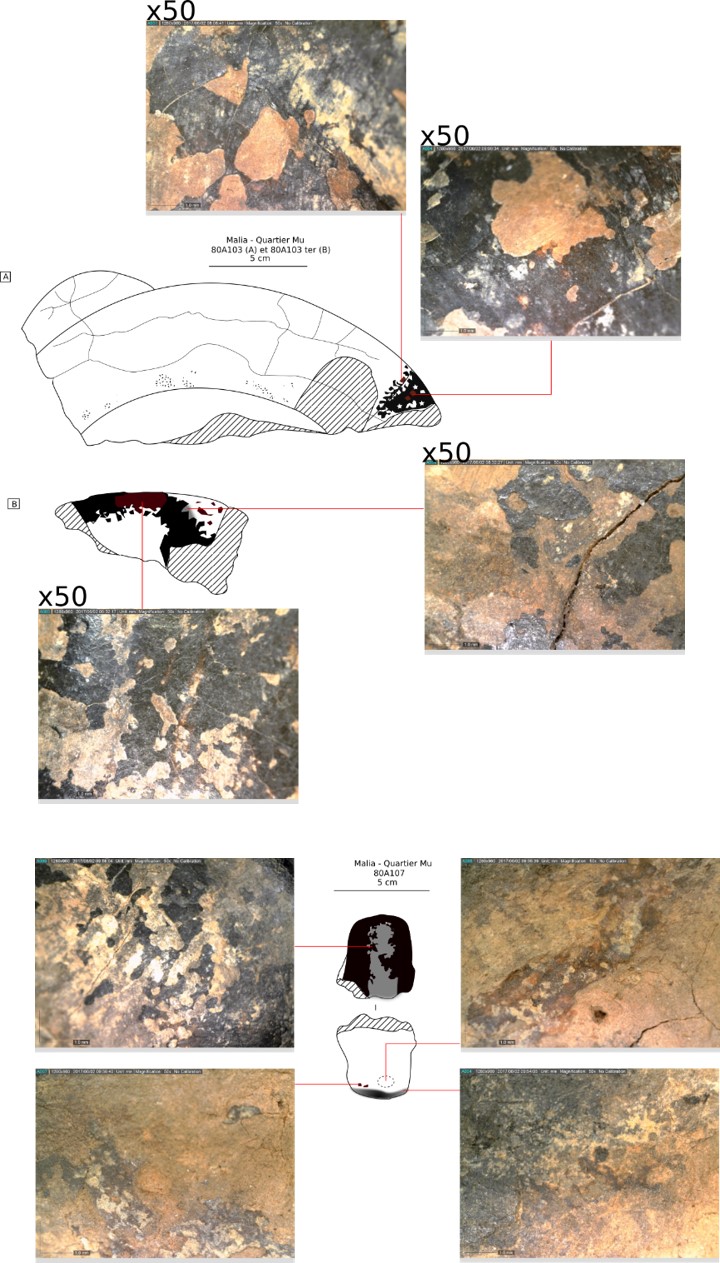
Conclusion
The very numerous lamps of the Quartier Mu in Malia and their spatial distribution suggest that they were used both during the daytime and nighttime.
Our experimental program revealed two functional groups. The first includes lamps that are easy to transport, but whose burn time is limited. The second includes lamps whose use was more stationary, but whose lighting duration could be very long (up to two consecutive days). The statistical and cartographic analysis of lamp distribution in the environment helps to establish a view of two spaces that correspond to this functional distinction, strongly suggesting that we interpret them as having been occupied in different fashion. In the south of the quarter, there is an overrepresentation of mobile lamps offering limited burn time. One can assume that this space was frequented occasionally, with short stays. Stationary lamps offering longer burn times are overrepresented in the north of the quarter, including in outdoor areas. This space could therefore have been much more suitable for daily use.
From the point of view of craft activities, a few suggestions have been made: hand lamps could have been part of metallurgic production, with pedestalled lamps lighting seated activities, such as the production of clay vases. These hypotheses of course call for subsequent testing, however they highlight a promising avenue of investigation in determining the location of production zones within Minoan settlements, which still remains a major problem.63
In any case, in buildings with confined rooms clustered together, the transition from darkness to light was instantaneous. It is an aspect that should be taken into account when exploring lived spaces in ancient societies. This dialectic deserves to be explored further through an ethnoarcheological approach. In a number of areas in the world, there are places without electricity where people continue to use oil lamps and candles for lighting. How do darkness and light accompany everyday activities (cooking, working, etc.)? Further ethnographic studies would help answer this question.
- 1. Raphaël Orgeolet, Maia Pomadère, « Formes et déformations de la ville égéenne. Akrotiri et les villes minoennes au prisme de l'historiographie récente », in Stéphane Bourdin, Michel Paoli, Anne Reltgen-Tallon (eds.), La Forme de la ville de l'Antiquité à la Renaissance (Rennes : PUR, 2015).
- 2. Jacques Levy, Michel Lussault (dir.), Dictionnaire de la géographie, (Paris : Belin, 2003), 1010.
- 3. Kostis Christakis, The Politics of Storage: Storage and Sociopolitical Complexity in Neopalatial Crete, (Philadeplphia: INSTAP Academic Press, 2008), 183.
- 4. Jan Driessen, Isle Schoep, Robert Laffineur (eds.), Monuments of Minos: Rethinking the Minoan Palaces (Liège, Austin : Université de Liège, University of Texas Program in Aegean Scripts and Prehistory, 2002), 248.
- 5. Mary Shepperson, Sunlight and Shade in the First Cities: a Sensory Archaeology of Early Iraq (Göttingen: Vandenhoeck & Ruprecht, 2017), 263.
- 6. Ioannis Roussos, Alan Chalmers, “High Fidelity Lighting of Knossos”, in David A. Arnold, Alan Chalmers, Franco Niccolucci (eds.), The 4th International Symposium on Virtual Reality, Archaeology and Intelligent Cultural Heritage (Aire-la-Ville : Eurographics Association 2003).
- 7. Constantinos Papadopoulos, Yannis Sakellarakis, “Virtual Windows to the Past: Reconstructing the ‘Ceramics Workshop’ at Zominthos, Crete”, in Francisco Javier Melero Columbrí, Francisco Contreras, Mercedes Farjas (eds.), Fusion of Cultures. Proceedings of the 38th Annual Conference on Computer Applications and Quantitative Methods in Archaeology, Granada, Spain, April 2010 (Oxford: Archaeopress 2010).
- 8. David Petrut, Monica Gui, Horea Trinca, “Lighting Roman military Barracks. An interdisciplinary Approach Based on Evidence from Dacia”, Archaeologica Bulgaria, vol. XVIII/3, 2014.
- 9. Constantinos Papadopoulos, Yannis Sakellarakis, “Virtual Windows to the Past: Reconstructing the ‘Ceramics Workshop’ at Zominthos, Crete”, in Francisco Javier Melero Columbrí, Francisco Contreras, Mercedes Farjas (eds.), Fusion of Cultures. Proceedings of the 38th Annual Conference on Computer Applications and Quantitative Methods in Archaeology, Granada, Spain, April 2010 (Oxford: Archaeopress 2010).
- 10. Marion Dowd, Robert Hensey (eds.), The Archaeology of Darkness (Oxford: Oxbow Books, 2016), 143 ; Nancy Gonlin, April Nowell, Archaeology of the Night: Life after Dark in Ancient World (Boulder: University Press of Colorado, 2018), 442.
- 11. Lucy Goodison, “From Tholos Tomb to Throne Room: Perceptions of the Sun in Minoan Ritual”, in Robert Laffineur, Robin Hägg (eds.), Potnia: Deities and Religion in Aegean Bronze Age (Liège, Austin : Université de Liège, University of Texas, Program in Aegean scripts and prehistory, 2001) ; Constantinos Papadopoulos, Graeme Earl, “Formal Three-dimensional Computational Analyses of Archaeological Spaces”, in Elefteria Paliou, Undine Lieberwirth, Silvia Polla (eds.), Spatial Analysis in Past Built Spaces – Workshops (Berlin, 1-2 april 2010) (Berlin : De Gruyter, 2014).
- 12. Philippe Bruneau, « La Maison délienne », Revue d’Archéologie moderne et d’Archéologie générale, vol. 12/4, 1994-1995.
- 13. Windows, doors, light wells, porticoes, inner courtyards (Calliopi Christofi, « L’Éclairage et l’aération dans les constructions de l'âge du bronze en Crète » (Ph.D diss., Université Paris 1 Panthéon-Sorbonne, 1993), 530).
- 14. Jean-Claude Poursat, Carl Knappett, La Poterie du minoen moyen II : production et utilisation : fouilles exécutées à Malia : le quartier Mu. IV (Athènes : École française d'Athènes ; Paris : De Boccard, 2005), 193-194.
- 15. Jean-Claude Poursat, Guide de Malia au temps des premiers palais : le quartier Mu (Paris : De Boccard, 1992), 10.
- 16. Poursat, Knappett, La Poterie du minoen moyen II, 194 (cf. note 14).
- 17. Jean-Claude Poursat, Le Quartier Mu. 1, Introduction générale / Écriture hiéroglyphique crétoise (Paris : P. Geuthner, 1978), 23.
- 18. Jean-Claude Poursat, Vie quotidienne et techniques au minoen moyen II (Athènes : École Française d’Athènes, 2013), 3.
- 19. Poursat, Guide de Malia au temps des premiers palais, 10 (cf. note 15).
- 20. Jean-Claude Poursat, Fouilles exécutées à Malia : le quartier Mu. III, Les artisans minoens : les maisons-ateliers du quartier Mu (Athènes : École française d'Athènes ; Paris : De Boccard, 1996).
- 21. Poursat, Guide de Malia au temps des premiers palais, 9 (cf. note 15).
- 22. Poursat, Fouilles exécutées à Malia, 152-153 (cf. note 20).
- 23. Christofi, « L’Éclairage et l’aération », 530 (cf. note 13) ; Vasiliki Fotou, « Architecture néopalatiale en Crète : les bâtiments en dehors des palais et leurs fonctions » (Ph.D diss., Université Paris 1 Panthéon-Sorbonne., 2013), 1439.
- 24. Catherine Kopaka, « Aménagements intérieurs des habitations et activités domestiques en Crète et à Thera à l'âge du bronze » (Ph.D diss., Université Paris 1 Panthéon-Sorbonne, 1984), 416. Sandra Prevost-Dermakar, « Les Fours et les foyers domestiques en Égée au Néolithique et à l’âge du Bronze » (Master thesis: Université Paris 1 Panthéon-Sorbonne, 1993).
- 25. Richard P. Evershed, et al., “Fuel for Thought? Beeswax in Lamps and Conical Cups from Late Minoan Crete”, Antiquity, vol.71, n°274, 1997. Birgitta P. Hallager, “Some Light in LMIII Hand Lamps”, 10th International Cretological Congress, Khania, 1-8 octobre 2006 (Khania, Φιλολογικός Σύλλογος "Ο Χρυσόστομος", 2011), 71-80. Joseph A. MacGillivray, Knossos: Pottery Groups of the Old Palace Period (London: British School at Athens, 1998), 153. Liliana Mercando, « Lampade, lucerne, braccieri di Festos », Annuario della Scuola archeologica di Atene e delle missioni italiene in Oriente, vol. 52-53, new series 36-37, 1978. Poursat, Fouilles exécutées à Malia, 268 (cf. note 20). Jeremy Rutter, “What Happened to the Lights? Changes in the Usage of Ceramic Lamps at Neopalatial and Early Postpalatial Kommos”, in Giampaolo Graziado, et al. (eds.), Φιλική Συναυλία. Studies in Mediterranean Archaeology for Mario Benzi, (Oxford: Archaeopress, 2013), 31-38. Peter Warren, Minoan Stone Vases (Cambridge: University press, 1969), 280.
- 26. Laurent Chrzanovski, De Prométhée à la Fée Électricité. Pour une sociologie de l’éclairage à travers les âges, les croyances et les continents (Cluj : Académie Roumaine, Centre d'Études Transylvaines ; Cluj-Napoca : Argonaut, 2013), 327.
- 27. Ünsal Yalçin, Cemal Pulak, Rainer Slotta, Das Schiff von Uluburun: Welthandel vor 3000 Jahren: Katalog der Ausstellung des Deutschen Bergbau-Museums Bochum vom 15. Juli 2005 bis 16. Juli 2006 (Bochum : Deutsches Bergbau-Museums, 2005), 332
- 28. Jan Driessen (personal oral communication, August 2015), to whom I would like offer special thanks.
- 29. José L. Melena, « La Produccion de plantas aromaticas en Cnoso », Estudios Clasicos, 78, 1975. José L. Melena, “Olive Oil and Other Sorts of Oil in the Mycenaean Tablets”, Minos: Revista de filologia egea, 18/1-2, 1983. Françoise Rougemont, “Oil at Nuzi and in the Linear B Records. A First Step Towards a Comparative Study”, in Manfried Dietrich, Oswald Loretz (dir.), Ugarit-Forschungen. Interationales Jahrbuch für die Altertumskunde Syrien-Palästinas (Münster : Ugarit Verlag, 2011), 345-410.
- 30. A new research mission raised this number to 184 lamps, 169 of which are made of clay, and 15 of stone. This information was not considered in the spatial analysis, as it does not appear to modify the proportions represented by each group.
- 31. Poursat, Fouilles exécutées à Malia, 121-123 (cf. note 20).
- 32. Warren, Minoan Stone Vases, 49-60 (cf. note 25).
- 33. Roxane Dubois, « Le Quartier Mu (Malia, Crète). Étude fonctionnelle d’un important complexe archéologique du Minoen Moyen IIB » (Master thesis, Université catholique de Louvain, 2017).
- 34. Poursat, Fouilles exécutées à Malia, 124 (cf. note 20).
- 35. Id.
- 36. Pierre Demargne, Fouilles exécutées à Mallia : exploration des nécropoles, 1921-1933 (Paris : Libr. orientaliste P. Geuthner, 1945), 71.
- 37. Poursat, Fouilles exécutées à Malia, 124 (cf. note 20).
- 38. Id.
- 39. Jeffrey Soles, Kostis Davaras (eds.), Mochlos IC: Period III. Neopalatial Settlement on the Coast: The Artisans’ Quarter and the Farmhouse at Chalinomouri. The Small Finds, (Philadelphia: INSTAP Academic Press, 2004) ; Photograph taken from Élise Morero, « Artisanat lapidaire en Crète minoenne. Les techniques de fabrication des vases en pierre » (Ph.D diss., Université Paris 1 Panthéon-Sorbonne, 2009), 22. Élise Morero, Méthodes d’analyse des techniques lapidaires. Les vases de pierre en Crète à l’âge du Bronze (IIIè-IIè millénaire av. J.-C.) (Paris : Publications de la Sorbonne, 2016), 311.
- 40. Harriet Blitzer, “Olive Cultivation and Oil Production in Minoan Crete”, in Marie-Claire Amouretti, Jean-Pierre Brun (dir.), La production de vin et d’huile en Méditerranée. Actes du symposium international organisé par le centre Camille Jullian (Université de Provençe –C.N.R.S.) et le Centre archéologique du Var (Aix-en-Provençe et Toulon, 20 -22 November 1991) (Paris : De Boccard, 1993), 55-64. Sytze Bottema, Anaya Sarpaki, “Environmental Change in Crete: a 9000-Year Record of the Holocene Vegetation History and the Effect of the Santorini Eruption”, The Holocene, vol. 13, n°5, 2003.
- 41. Katerina Trantalidou, “Animals and Human Diet in the Prehistoric Aegean”, in David A. Hardy (eds.), Thera and the Aegean World III, volume two, earth sciences. Proceedings of the third international congress, Santorini, Greece, 3-9 September 1989 (London: The Thera Foundation, 1990), 392-403.
- 42. Marie-Louise Nosch, « The Textile Logograms in the Linear B Tablets: Les idéogrammes archéologiques des textiles», in Pierre Carlier, et al. (dir.), Études mycéniennes 2010 : actes du XIIIe Colloque international sur les textes égéens, Sèvres, Paris, Nanterre, 20-23 septembre 2010 (Pise, F. Serra, 2012), 305-346. Françoise Rougemont, “Flax and Linen Textiles in the Mycenaean Economy”, in Carole Gillis, Marie-Louise Nosch (eds.), Ancient textiles: production, craft and society: Proceedings of the first International conference on ancient textiles, held at Lund, Sweden, and Copenhagen, Denmark, on March 19-23, 2003 (Oxford: Oxbow books, 2008), 46-49.
- 43. Dorina Moullou, et al., “Lighting in Antiquity”, Balkan Light 2012, 3-5 October 2012, (Belgrade : s.m., 2012), 237-244.
- 44. Evershed, et al., “Fuel for Thought?” (cf. note 25).
- 45. Styrofoam balls, whose usefulness has been proven by a number of functional analyses of ceramic objects, have the distinctive characteristic of adopting physical behavior similar to that of water. For the protocol used, cf. Cydrisse Cateloy, « Trade and Capacity Studies in the Eastern Mediterranean: the First Levantine Trade Amphorae », in Bernard Knapp, Stella Demesticha (eds.), Mediterranean Connections: Maritime Transport Containers and Seaborne Trade in the Bronze and Early Iron Ages (New York: Routledge, 2017), 39-55.
- 46. In this experiment, lamp II was not used, as two bowls of different size were enough to measure the importance of capacity as a parameter (I = deep; III = shallow).
- 47. Bastien Rueff, “Characterizing Lighting Ambiances through the Study of Lamps in Kommos City (Crete) during the Bronze Age (3200 – 1100 B.C.)”, in Laurent Chrzanovski (eds.), Vth ILA Congress, held at Sibiu (Romania), September 2015 (forthcoming).
- 48. Marie-Claire Amouretti, Le Pain et l’huile dans la Grèce antique : de l’araire au moulin (Paris : Les Belles Lettres, 1986), 190.
- 49. Bruno Desachy, « Explographe 1.0. Application de traitement graphique de tableaux de données sous LibreOffice Calc. Mode d’emploi. Document provisoire », [online], available at <https://abp.hypotheses.org/le-programme-bassin-parisien/les-projets/les…;, (consulted on 30/03/2018), (n.p., September 2016).
- 50. Poursat, Fouilles exécutées à Malia, 268 (cf. note 20).
- 51. Poursat, Guide de Malia au temps des premiers palais, 37 (cf. note 15).
- 52. Ibid., 39. Poursat, Le Quartier Mu, 69 (cf. note 17).
- 53. Id.
- 54. Romain Prévalet, « La Décoration des pièces d’orfèvrerie-bijouterie en Méditerranée orientale à l’âge du Bronze : techniques, productions, transmissions » (Ph.D diss., Université Paris 1 Panthéon-Sorbonne, 2013).
- 55. Olivier Untracht, « L’Orfèvre indien », in Laurence Mattet (dir.), Inde : Bijoux en or des collections du musée Barbier-Mueller (Paris : Somogy éditions d’art, 2004), 62-73.
- 56. Poursat, Guide de Malia au temps des premiers palais, 48 (cf. note 15).
- 57. Dubois, « Le Quartier Mu (Malia, Crète) », 108 (cf. note 33).
- 58. Clairy Palyvou, “Outdoor Space in Minoan Architecture: ‘Community and Privacy’”, Gerald Cadoga, Eleni Hatzaki, Adonis Vasilakis (eds.), Knossos: Palace, City, State. Proceedings of the conference in Herakleion organized by the British school at Athens Studies and the 3rd Ephoreia of prehistoric and classical antiquities of Herakleion, in November 2000, for the centenary of Sir Arthur Evans’ excavations at Knossos (London: British School at Athens studies, 2004), 207-217.
- 59. Serge Chermayeff, Christopher Alexander, Community and Privacy: toward a New Architecture of Humanism (Hardmondsworth, Ringwood: Penguin Books, 1966), 255.
- 60. Poursat, Le Quartier Mu, 198 (cf. note 17).
- 61. Poursat, Vie quotidienne et techniques au minoen moyen II, (cf. note 18).
- 62. A hand lamp (80A80) and two pedestalled lamps (80A107 ; 80A103-106) were published (respectively nos. A101, A143, and A163 in Jean-Claude Poursat, Vie quotidienne et techniques au minoen moyen II, op. cit., 216-218 (cf. note 18); however, after visual examination, we propose recognizing an additional pedestalled lamp (80A107_bis) and hand lamp (80A107_ter).
- 63. Don Evely, “Minoan Craftsmen: Problems of Recognition and Definition”, Elizabeth Bayard French, Kenneth Wardle (eds.), Problems on Greek Prehistory, Papers presented at the Centenary Conference of the British School of Archaeology at Athens, Manchester, April 1986, (Bristol: Bristol Classical Press, 1988), 397-415.
Amouretti Marie-Claire, Le Pain et l’huile dans la Grèce antique : de l’araire au moulin (Paris : Les Belles Lettres, 1986).
Blitzer Harriet, « Olive cultivation and oil production in minoan Crete », in Marie-Claire Amouretti, Jean-Pierre Brun (dir.), La Production de vin et d’huile en Méditerranée. Actes du symposium international organisé par le centre Camille Jullian (Université de Provence –C.N.R.S.) et le Centre archéologique du Var (Aix-en-Provence et Toulon, 20 -22 novembre 1991) (Paris : De Boccard, 1993), 55-64.
Bottema Sytze, Sarpaki Anaya, “Environmental Change in Crete: a 9000-Year Record of the Holocene Vegetation History and the Effect of the Santorini Eruption”, The Holocene, vol. 13, n°5, 2003, 733-749.
Bruneau Philippe, « La Maison délienne », Revue d’Archéologie moderne et d’Archéologie générale, vol. 12/4, 1994-1995, 77-118.
Cateloy Cydrisse, “Trade and Capacity Studies in the Eastern Mediterranean: the First Levantine Trade Amphorae”, in Bernard Knapp, Stella Demesticha (eds.), Mediterranean Connections: Maritime Transport Containers and Seaborne Trade in the Bronze and Early Iron Ages, (New York: Routledge, 2017), 39-55.
Christakis Kostis, The Politics of Storage: Storage and Sociopolitical Complexity in Neopalatial Crete (Philadeplphia: INSTAP Academic Press, 2008).
Christofi Calliopi, « L’Éclairage et l’aération dans les constructions de l'âge du bronze en Crète » (thèse de Doctorat, Université Paris 1 Panthéon-Sorbonne, 1993).
Chrzanovski Laurent, De Prométhée à la Fée Électricité. Pour une sociologie de l’éclairage à travers les âges, les croyances et les continents (Cluj : Académie Roumaine, Centre d'Études Transylvaines ; Cluj-Napoca : Argonaut, 2013).
Darcque Pascal, Van de Moortel Aleydis, Schmid Martin, Fouilles exécutées à Malia : les abords Nord-Est du palais. I, Les recherches et l’histoire du secteur (Athènes : École française d’Athènes, 2014).
Demargne Pierre, Fouilles exécutées à Mallia : exploration des nécropoles, 1921-1933 (Paris : Libr. orientaliste P. Geuthner, 1945).
Desachy Bruno, « Explographe 1.0. Application de traitement graphique de tableaux de données sous LibreOffice Calc. Mode d’emploi. Document provisoire », Url : https://abp.hypotheses.org/le-programme-bassin-parisien/les-projets/les-projets-associes-au-programme/outils-danalyse-graphique-des-donnees (consulté le 30/03/2018).
Driessen Jan, Schoep Isle, Laffineur Robert (eds.), Monuments of Minos: Rethinking the Minoan Palaces : proceedings of the International workshop “Crete of the hundred palaces?” held at the Université Catholique de Louvain, Louvain-la-Neuve, 14-15 décembre 2001 (Liège, Austin : Université de Liège, University of Texas Program in Aegean Scripts and Prehistory, 2002).
Dubois Roxane, « Le Quartier Mu (Malia, Crète). Étude fonctionnelle d’un important complexe archéologique du Minoen Moyen IIB » (mémoire de Maîtrise, Université Paris 1 Panthéon-Sorbonne, 2017).
Dowd Marion, Hensey Robert (eds.), The Archaeology of Darkness (Oxford: Oxbow Books, 2016).
Evely Don, “Minoan Craftsmen: Problems of Recognition and Definition”, in Elizabeth Bayard French, Kenneth Wardle (eds.), Problems on Greek Prehistory, Papers presented at the Centenary Conference of the British School of Archaeology at Athens, Manchester, April 1986, (Bristol: Bristol Classical Press, 1988), 397-415.
Evershed Richard P. et al., “Fuel for Thought? Beeswax in Lamps and Conical Cups from Late Minoan Crete”, Antiquity, vol.71, n°274, 1997, 979-985.
Fotou Vasiliki, « Architecture néopalatiale en Crète : les bâtiments en dehors des palais et leurs fonctions » (thèse de Doctorat, Université Paris 1 Panthéon-Sorbonne, 2013).
Gonlin Nancy, Nowell April (eds.), Archaeology of the Night: Life after Dark in Ancient World (Boulder: University Press of Colorado, 2018).
Goodison Lucy, “From Tholos Tomb to Throne Room: Perceptions of the Sun in Minoan Ritual”, in Robert Laffineur, Robin Hägg (eds.), Potnia: Deities and Religion in Aegean Bronze Age (Liège: Université de Liège; Austin: University of Texas, Program in Aegean scripts and prehistory, 2001), 339-350.
Hallager Birgitta P., “Some Light in LMIII Hand Lamps”, 10th International Cretological Congress, Khania, 1-8 octobre 2006 (Khania, Φιλολογικός Σύλλογος "Ο Χρυσόστομος", 2011), 71-80.
Kopaka Catherine, « Aménagements intérieurs des habitations et activités domestiques en Crète et à Thera à l'âge du bronze » (thèse de Doctorat, Université Paris 1 Panthéon-Sorbonne, 1984).
Levy Jacques, Lussault Michel (dir.), Dictionnaire de la géographie (Paris : Belin, 2003).
MacGillivray Joseph A., Knossos: Pottery Groups of the Old Palace Period (London: British School at Athens, 1998).
Melena José L., « La Produccion de plantas aromaticas en Cnoso », Estudios Clasicos, 78, 1975, 177-190.
Melena José L., “Olive Oil and Other Sorts of Oil in the Mycenaean Tablets”, Minos : Revista de filologia egea, 18/1-2, 1983, 89-123.
Mercando Liliana, « Lampade, lucerne, braccieri di Festos », Annuario della Scuola archeologica di Atene e delle missioni italiene in Oriente, vol. 52-53, nouvelle série 36-37, 1978.
Morero Élise, « Artisanat lapidaire en Crète minoenne. Les techniques de fabrication des vases en pierre » (thèse de Doctorat, Université Paris 1 Panthéon-Sorbonne, 2009).
Morero Élise, Méthodes d’analyse des techniques lapidaires. Les vases de pierre en Crète à l’âge du Bronze (IIIè-IIè millénaire av. J.-C.) (Paris : Publications de la Sorbonne, 2016).
Dorina Moullou et al., “Lighting in Antiquity”, Balkan Light 2012, 3-5 octobre 2012, (Belgrade : s.m., 2012), 237-244.
Nosch Marie-Louise, « The Textile Logograms in the Linear B Tablets: Les Idéogrammes archéologiques des textiles », in Pierre Carlier et al. (dir.), Études mycéniennes 2010 : actes du XIIIe Colloque international sur les textes égéens, Sèvres, Paris, Nanterre, 20-23 septembre 2010 (Pise : F. Serra, 2012), 305-346.
Orgeolet Raphaël, Pomadère Maia, « Formes et déformations de la ville égéenne. Akrotiri et les villes minoennes au prisme de l’historiographie récente », in Stéphane Bourdin, Michel Paoli, Reltgen-Tallon Anne (dir.), La Forme de la ville de l’Antiquité à la Renaissance, (Rennes : PUR, 2015), 365-383.
Palyvou Clairy, “Outdoor Space in Minoan Architecture: ‘Community and Privacy’”, in Gerald Cadoga, Eleni Hatzaki, Adonis Vasilakis (eds.), Knossos: Palace, City, State. Proceedings of the conference in Herakleion organized by the British school at Athens Studies and the 3rd Ephoreia of prehistoric and classical antiquities of Herakleion, in November 2000, for the centenary of Sir Arthur Evans’ excavations at Knossos (London: British School at Athens studies, 2004), 207-217.
Papadopoulos Constantinos, Earl Graeme, “Formal Three-dimensional Computational Analyses of Archaeological Spaces”, in Elefteria Paliou, Undine Lieberwirth, Silvia Polla (eds.), Spatial analysis in Past Built Spaces – Workshops (Berlin, 1-2 april 2010) (Berlin : De Gruyter, 2014), 135-165.
Papadopoulos Constantinos, Sakellarakis Yannis, “Virtual Windows to the Past: Reconstructing the ‘Ceramics Workshop’ at Zominthos, Crete”, in Francisco Javier Melero Columbrí, Francisco Contreras, Mercedes Farjas (eds.), Fusion of Cultures. Proceedings of the 38th Annual Conference on Computer Applications and Quantitative Methods in Archaeology, Granada, Spain, April 2010 (Oxford: Archaeopress 2010), 47-54.
Petrut David, Gui Monica, Trinca Horea, “Lighting Roman military Barracks. An interdisciplinary Approach Based on Evidence from Dacia”, Archaeologica Bulgaria, XVIII/3, 2014, 65-92.
Poursat Jean-Claude, Le Quartier Mu. 1, Introduction générale / Écriture hiéroglyphique crétoise (Paris : P. Geuthner, 1978).
Poursat Jean-Claude, Guide de Malia au temps des premiers palais : le quartier Mu (Paris : De Boccard, 1992).
Poursat Jean-Claude, Fouilles exécutées à Malia : le quartier Mu. III, Les artisans minoens : les maisons-ateliers du quartier Mu (Athènes : École française d’Athènes ; Paris : De Boccard, 1996).
Poursat Jean-Claude, Knappett Carl, La Poterie du minoen moyen II : production et utilisation : fouilles exécutées à Malia : le quartier Mu. IV (Athènes : École française d'Athènes ; Paris : De Boccard, 2005).
Poursat Jean-Claude, Vie quotidienne et techniques au minoen moyen II (Athènes : École Française d’Athènes, 2013).
Prévalet Romain, « La Décoration des pièces d’orfèvrerie-bijouterie en Méditerranée orientale à l’âge du Bronze : techniques, productions, transmissions » (thèse de Doctorat, Université Paris 1 Panthéon-Sorbonne, 2013).
Prevost-Dermakar Sandra, « Les Fours et les foyers domestiques en Égée au Néolithique et à l’âge du Bronze » (mémoire de Maîtrise, Université Paris 1 Panthéon-Sorbonne, 1993).
Rougemont Françoise, “Flax and Linen Textiles in the Mycenaean Economy”, in Carole Gillis, Marie-Louise Nosch (eds.), Ancient Textiles: Production, Craft and Society: Proceedings of the first International conference on ancient textiles, held at Lund, Sweden, and Copenhagen, Denmark, on March 19-23, 2003 (Oxford: Oxbow books, 2008), 46-49.
Rougemont Françoise, “Oil at Nuzi and in the Linear B Records. A First Step Towards a Comparative Study”, in Manfried Dietrich, Oswald Loretz (eds.), Ugarit-Forschungen. Interationales Jahrbuch für die Altertumskunde Syrien-Palästinas (Münster : Ugarit Verlag, 2011), 345-410.
Roussos Ioannis, Chalmers Alan, “High Fidelity Lighting of Knossos”, in David A. Arnold, Alan Chalmers, Franco Niccolucci (eds.), The 4th International Symposium on Virtual Reality, Archaeology and Intelligent Cultural Heritage (Aire-la-Ville : Eurographics Association 2003), 195-202.
Rueff Bastien, “Characterizing Lighting Ambiances through the Study of Lamps in Kommos City (Crete) during the Bronze Age (3200 – 1100 B.C.)”, in Laurent Chrzanovski (eds.), Vth ILA Congress, held at Sibiu (Romania), September 2015 (forthcoming).
Rutter Jeremy, “What Happened to the Lights? Changes in the Usage of Ceramic Lamps at Neopalatial and Early Postpalatial Kommos”, in Giampaolo Graziado et al. (eds.), Φιλική Συναυλία. Studies in Mediterranean Archaeology for Mario Benzi (Oxford: Archaeopress, 2013), 31-38.
Shaw Maria C., “Late Minoan Hearts and Ovens at Kommos, Crete”, in Pascal Darcque, René Treuil (dir.), L’Habitat égéen préhistorique. Actes de la Table Ronde internationale organisée par le Centre de la Recherche Scientifique, l'Université de Paris 1 et l’École française d'Athènes (Athènes, 23-25 juin 1987) (Athènes : École française d’Athènes ; Paris : De Boccard, 1990), 231-254.
Soles Jeffrey, Davaras Kostis (eds.), Mochlos IC: Period III. Neopalatial Settlement on the Coast: The Artisans’ Quarter and the Farmhouse at Chalinomouri. The Small Finds, (Philadelphia: INSTAP Academic Press, 2004).
Trantalidou Katerina, “Animals and Human Diet in the Prehistoric Aegean”, in David A. Hardy (eds.), Thera and the Aegean World III, volume two, earth sciences. Proceedings of the third international congress, Santorini, Greece, 3-9 September 1989 (London: The Thera Foundation, 1990), 392-403.
Treuil René et al., Les civilisations égéennes du Néolithique et de l’âge du Bronze (Paris : Presses Universitaires de France, 2008).
Shepperson Mary, Sunlight and Shade in the First Cities: a Sensory Archaeology of Early Iraq (Göttingen: Vandenhoeck & Ruprecht, 2017).
Warren Peter, Minoan Stone Vases (Cambridge: University press, 1969).
Yalçin Ünsal, Pulak Cemal, Slotta Rainer, Das Schiff von Uluburun: Welthandel vor 3000 Jahren: Katalog der Ausstellung des Deutschen Bergbau-Museums Bochum vom 15. Juli 2005 bis 16. Juli 2006 (Bochum : Deutsches Bergbau-Museums, 2005).
